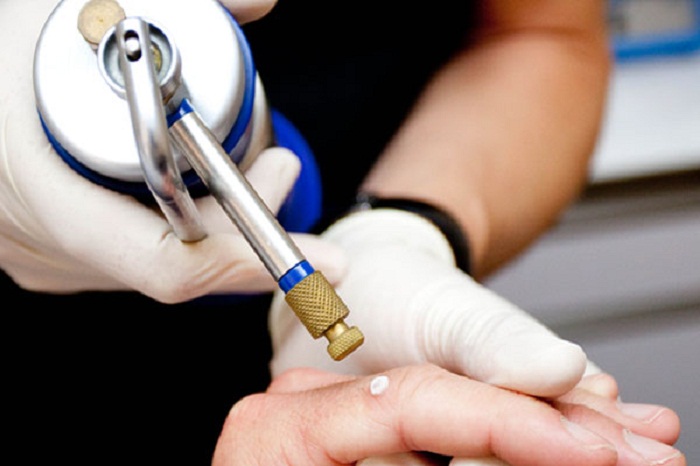Cryosurgery
(cryotherapy) is the use of extreme cold produced by liquid nitrogen
(or argon gas) to destroy abnormal tissue. Cryosurgery is used to treat
external tumors, such as those on the skin. For external tumors, liquid nitrogen is applied directly to the cancer
cells with a cotton swab or spraying device. Cryosurgery is also used
to treat tumors inside the body (internal tumors and tumors in the
bone). For internal tumors, liquid nitrogen or argon gas is circulated
through a hollow instrument called a cryoprobe, which is placed in
contact with the tumor. The doctor uses ultrasound or MRI to guide the
cryoprobe and monitor the freezing of the cells, thus limiting damage to
nearby healthy tissue. A ball of ice crystals forms around the probe,
freezing nearby cells. Sometimes more than one probe is used to deliver
the liquid nitrogen to various parts of the tumor. The probes may be put
into the tumor during surgery or through the skin (percutaneously).
After cryosurgery, the frozen tissue thaws and is either naturally
absorbed by the body (for internal tumors), or it dissolves and forms a
scab (for external tumors). Cryotherapy is a local treatment where it
only treats the area of Cancer treatment. It doesn’t treat any cancer
cells in other parts of the body. After the treatment the body’s immune system gets rid of the dead tissue over a few weeks.
Advantages: Cryosurgery offers advantages over other methods of cancer treatment.
It is less invasive than surgery, involving only a small incision or
insertion of the cryoprobe through the skin. Consequently, pain,
bleeding, and other complications of surgery are minimized. Cryosurgery
is less expensive than other treatments and requires shorter recovery
time and a shorter hospital stay, or no hospital stay at all. Sometimes
cryosurgery can be done using only local anesthesia. Because physicians
can focus cryosurgical treatment on a limited area, they can avoid the
destruction of nearby healthy tissue. The treatment can be safely
repeated and may be used along with standard treatments such as surgery,
chemotherapy, hormone therapy and radiation. Cryosurgery may offer an
option for treating cancers that are considered inoperable or that do
not respond to standard treatments. Furthermore, it can be used for
patients who are not good candidates for conventional surgery because of
their age or other medical conditions.
Disadvantages:
The major disadvantage of cryosurgery is the uncertainty surrounding
its long-term effectiveness. While cryosurgery may be effective in
treating tumors the physician can see by using imaging tests (tests that
produce pictures of areas inside the body), it can miss microscopic cancer spread. Furthermore, because the effectiveness of the technique is still being assessed, insurance coverage issues may arise.

No comments:
Post a Comment